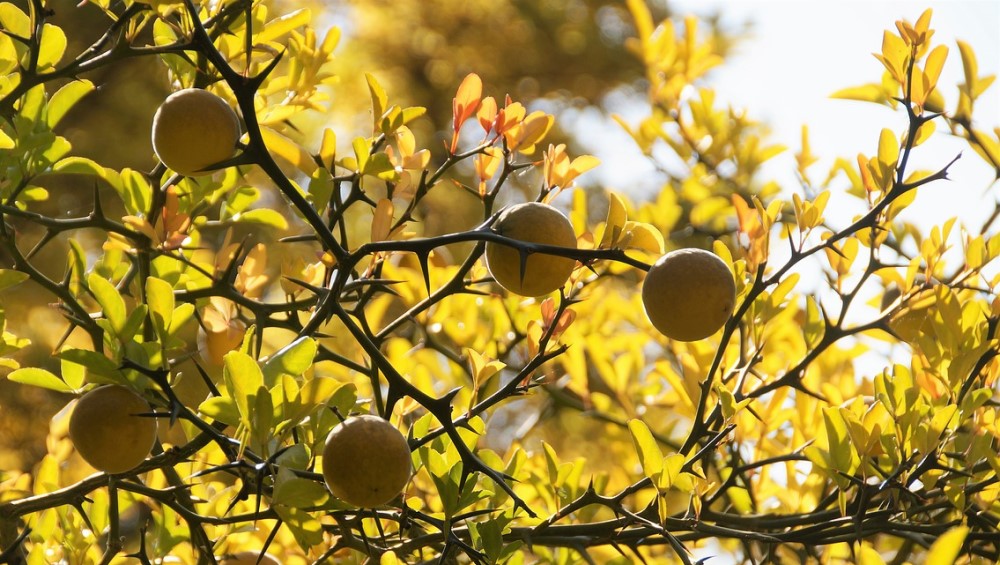Lemon tree thorns are not poisonous and contain no substance that are particularly dangerous. Lemon tree thorns can carry bacteria however so always wear garden gloves and long sleeves when pruning a tree that has thorns. You can remove larger thorns with secateurs to make the tree safer.
Always contact a doctor if you feel you have any problems caused by scratches or pokes from lemon tree thorns. Protect yourself with gloves, long sleeves and protective glasses if you are ready to prune.

This article will explore all you need to know about lemon tree thorns, how to keep yourself and your pets safe and some easy tips for preventing scratches.
Why lemon trees grow thorns
Lemon trees will naturally grow thorns to protect themselves from predators. To stop the stems and leaves from being attacked, lemon trees grow thorns to deter creatures that are trying to snack on them.
How to prevent scratches from lemon tree thorns
If your lemon tree has thorns then it is important to protect yourself when it is time to prune. Always use sharp secateurs to make sure the cut is clean and it heals quickly. To protect yourself from scratches from the thorns follow these easy tips.
1. Wear gloves
Wearing gardening gloves is very important when pruning lemon trees to protect your hands from the thorns. Leather gloves will offer the best protection but you can also choose nylon. I have a pair of gloves made for building jobs which has a combination of synthetic leather and fabric.
The strong and thicker the gloves are the better, this will stop the thorns from poking through when you grab the branches.
2. Wear long sleeves
Protect your arms from the lemon tree thorns by wearing long sleeves. A workers shirt is best because the material will be thick and stop scratches from the thorns.
Wear a thick jacket if the weather is cold for even more protection but make sure it is an old one. Lemon tree thorns are tough and can tear material easily.
3. Wear protective eyewear
Wear protective eyewear to save your eyes from the thorns. Sunglasses work well or wear some clear protective glasses that you can get from the hardware store. Eyewear is important when you are pruning to avoid any damage from the spines or stems.
How to keep pets safe from lemon tree thorns
If you have a thorny lemon tree then it is good to take some steps to protect your pets. Stem guards that are made to protect the tree will also protect your plants. Wrap them around the base of the tree to prevent pets from rubbing against the tree and getting spiked by the thorns.
You can also create a wider barrier from a wire cage. Choose strong wire and create a circle with the wire. Cover the wire with shade cloth and place it around the lemon tree. This will help to keep pets even further away from the tree avoiding the thorns.
Do thorns on lemon trees mean less lemons?
A lemon tree with lots of thorns can still grow lots of lemons. Common lemon tree varieties like Meyer lemons have lots of thorns but also produce lots of fruit. There is no link between the amount of spines and the amount of lemons.
The only thing to look out for is growth from below the graft point. These stems will not produce good quality fruit and usually have lots of thorns. Cut them off as close to the base of the stem as possible with sharp secateurs.
Why the lower branches of lemon trees have more thorns
Sometimes lemon trees can grow stems from below the graft. Grafted lemon trees will have the top part of their stem cut from a healthy, fruit producing plant while the bottom will be a strong growing root systems. Stems can grow below the graft which are often very spikey and will not produce fruit.
Always remove the stems that grow below the graft to avoid this. Cut them as close to the stem as possible. This will prevent them from growing back too quickly. Check your tree throughout the year to make sure it is not growing stems below the graft point.
Best lemon trees without thorns
Eureka lemon trees are a hybrid tree that has almost no thorns. This is a great option if you have pets or kids. They produce lots of delicious lemons and will avoid the problem of being spiked by thorns.
Lemon trees can grow larger thorns as they get bigger. Often the thorns will be small on a smaller tree so trim your tree regularly to keep it manageable.
Should I cut the thorns off a lemon tree?
You can cut thorns off a lemon tree if you like. This will not harm the tree but can be a time consuming job. Use sharp secateurs to snip off the thorns near the base of the stem. Some lemon trees produce lots of thorns so snip off the larger ones as they will be easier.
Place a tree or trunk protector around the base of the tree to cover a large area of thorns instead of chopping them off. This is a quicker process than snipping off all of the thorns.
Are lemon tree thorns poisonous? | Summary
Lemon tree thorns are not poisonous but can scratch you or your pets skin. Protect yourself when pruning lemon trees with gloves, long sleeves and glasses. Choose ‘Eureka’ lemon trees if you want to avoid the spines. This variety of lemon is almost spineless so is a great choice if you have pets or kids.
I am an accredited practicing dietitian, experienced gardener and a dedicated cook. I love writing and sharing my experience so you can learn from my successes and mistakes.
